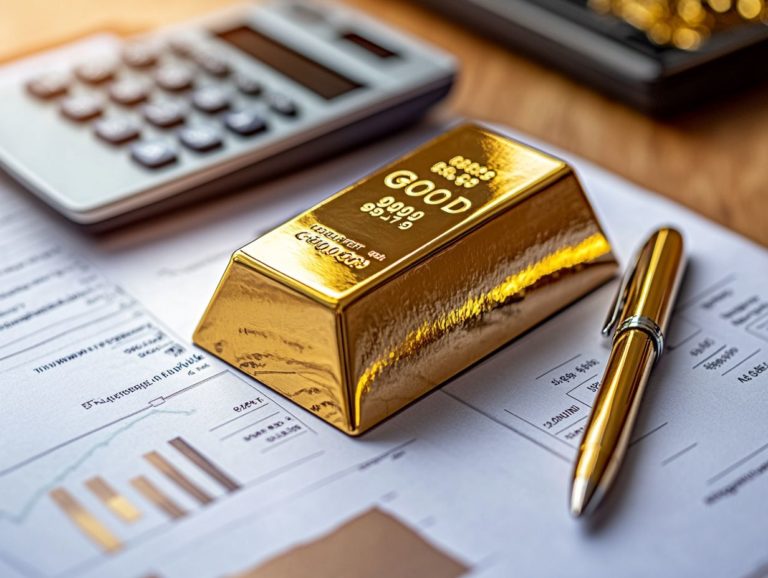What are the Historical Returns on Gold?
Gold has always been a symbol of wealth and stability. It’s a popular choice for investors looking to protect their assets.
This exploration dives into gold as an investment. We ll examine its rich history and current market status.
It also looks at historical returns and expert predictions for gold’s future performance. These insights can help you consider gold as a key part of your investment strategy.
Contents
Key Takeaways:

Throughout history, gold has been a popular investment due to its perceived stability and value.
The price of gold is influenced by various economic and geopolitical factors, making it a unique and dynamic investment.
Historically, gold has shown strong returns in different time periods and outperformed other investments in terms of risk and return.
Overview of Gold as an Investment
Investing in gold is a smart choice for diversifying your portfolio and protecting your wealth, especially in uncertain economic times.
Gold has delivered impressive returns, often outpacing traditional stocks like the S&P 500.
Its status as a symbol of wealth makes it a vital asset for any long-term investment strategy. Whether you choose gold ETFs or physical gold, you ll find unique value in the financial markets.
Brief History and Current Status
Gold has a rich history that goes back thousands of years. It started as a medium of exchange and later became a gold standard that shaped modern economies.
Notable figures like Franklin D. Roosevelt and Richard Nixon helped create laws around gold, including the important Gold Reserve Act.
As countries moved to government-issued money, gold became a safe haven during economic troubles, proving its strength during the Great Depression and other crises.
Today, financial tools like ETFs and futures make engaging with gold easier than ever, making it a versatile asset in a complex financial landscape.
Factors that Influence Gold Prices
Gold prices are shaped by many factors in the economic and geopolitical arenas, making it a dynamic asset.
Economic indicators like inflation rates and changes in global activity can greatly influence gold prices. Geopolitical tensions often increase demand for gold as it is seen as a safe haven in uncertain times.
Economic and Geopolitical Factors

Economic indicators like inflation and interest rates are pivotal in shaping gold prices. They often gauge your sentiment toward gold as an inflation hedge. Global events, such as the ongoing geopolitical tensions in Ukraine, can trigger spikes in gold prices as markets respond to heightened uncertainty.
This volatility highlights how shifts in the economic landscape like changes in consumer confidence and central bank policies can influence your demand for gold. For instance, when inflation rises, you might find yourself gravitating toward gold, viewing it as a safe option against currency devaluation.
Supply chain issues and global slowdowns can complicate the market, causing more speculation. In periods of political unrest, the gold market becomes especially reactive, underscoring its reputation as a reliable asset for safeguarding wealth amid chaos.
Therefore, discerning investors like you consistently monitor these dynamic factors to make well-informed decisions. By leveraging gold’s historical resilience, you can incorporate it into your overall investment strategy.
Historical Returns on Gold
The historical returns on gold consistently demonstrate its potential as a formidable investment, especially when compared to traditional assets like the S&P 500. Over the long term, gold has exhibited impressive price appreciation. It frequently delivers a favorable average return, even amidst occasional short-term volatility.
Performance in Different Time Periods
Gold consistently surprises investors with its resilience during challenging times, particularly during market downturns. Historical data reveals how gold excelled over the last decade, especially during economic crises.
Take, for instance, the tumultuous year of 2020. As the global economy faced upheaval from the pandemic, many investors flocked to gold. This resulted in a significant price surge that underscored its reputation as a safe haven.
Likewise, in 2022, amidst rising inflation and geopolitical uncertainties, gold once again demonstrated its value. It solidified its status as a reliable long-term investment option.
If you want to align your financial goals with stable assets, gold is a great choice. It not only acts as a hedge against market volatility but also serves as an effective store of value over time.
Comparing Gold to Other Investments
When you compare gold to other investments, such as stocks and bonds, it becomes clear that each asset class presents unique benefits and risks. Gold ETFs (Exchange-Traded Funds) and gold miner stocks offer alternative pathways for investing in gold. They enable you to effectively diversify your portfolio in the face of market volatility.
Risk and Return Analysis

Understanding the dynamics of risk and return in gold investments is vital for achieving your financial goals. Gold’s average return fluctuates based on market conditions and investor sentiment. The inherent volatility of the market can lead to price swings in gold, underscoring the necessity of a strategic investment approach.
As an investor, you should analyze how external factors such as geopolitical tensions and economic indicators affect gold prices over time. For example, during periods of heightened inflation or economic uncertainty, gold tends to be regarded as a safe haven, often driving prices upward.
Conversely, when confidence in the economy grows, people may buy less gold, resulting in price drops. Grasping these dynamics is essential for anyone seeking to incorporate gold into a diversified portfolio. Understanding the advantages of paper vs. physical gold can greatly influence your overall investment performance.
Predictions for Future Gold Returns
Predictions for future gold returns are influenced by a blend of expert insights, economic indicators, and current market trends. This creates a nuanced landscape for you as an investor.
With inflation expectations on the rise, it s widely believed that gold will not only retain its allure but may also amplify its status as a steadfast investment choice.
Expert Opinions and Forecasts
Expert opinions and forecasts about gold investments vary widely. Financial analysts provide valuable insights into potential price appreciation and market dynamics.
These analyses help you craft informed investment strategies in a constantly shifting market landscape. As central banks worldwide adjust interest rates and geopolitical tensions fluctuate, many experts anticipate a cautious yet upward trend for gold prices.
Analysts from esteemed institutions like JP Morgan and Goldman Sachs emphasize that, during times of economic uncertainty, gold is seen as a reliable investment.
Stay alert to these forecasts to seize opportunities! By keeping a close eye on them, you can adapt your portfolio to include more gold during periods of volatility. Understanding why choose physical gold over paper assets allows you to capitalize on pricing trends, positioning yourself to maximize returns while skillfully navigating potential risks.
Frequently Asked Questions
What are the Historical Returns on Gold?

The historical returns on gold refer to the percentage increase or decrease in the value of gold over a specific period. These returns help evaluate the performance of gold as an investment.
How are Historical Returns on Gold Calculated?
The historical returns on gold are calculated by comparing the current value of gold to its value at a previous point in time. This can be done on a daily, monthly, or annual basis, depending on the desired time frame.
What Factors Affect Historical Returns on Gold?
Historical returns on gold can be influenced by various factors, including global economic conditions, supply and demand, and geopolitical events. These factors can impact both the price of gold and the overall return on investment.
What is the Average Historical Return on Gold?
The average historical return on gold varies depending on the time period being considered. However, over the past 50 years, gold has shown an average return of around 7% per year, reflecting the typical percentage increase in value over time.
Are Historical Returns on Gold Guaranteed?
No, historical returns on gold are not guaranteed. Like any investment, the value of gold can fluctuate, and past performance does not guarantee future results. It is important to carefully consider the risks and potential returns before investing in gold.
How Can I Use Historical Returns on Gold in my Investment Strategy?
Historical returns on gold can serve as a benchmark for evaluating the performance of gold as an investment. They can also guide informed decisions about buying and selling gold, based on trends and potential returns.
Now that you understand gold’s potential, consider how it fits into your investment strategy!














